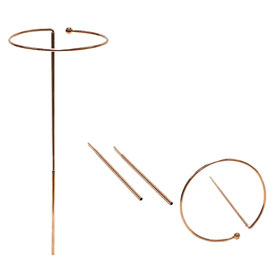- Amaryllis Lovers
Close X
A Glorious Gift Ready To Grow & Bloom!
-
Living
Gifts
-
- SHOP BY TYPE
- Bulb Gardens
- Garden Clubs
-
- Trees
- Gifts
-
- SHOP BY OCCASION
- Christmas
- Thanksgiving
- Hanukkah
- New Year
- Gift Exchange
- Birthday
- Thank You
- Holiday Party
-
- SHOP BY RECIPIENT
- Gardener
- Home Decorator
- Families
- Bird Lovers
- Teacher
- Business
- Nature Lovers
- Hostess
- Book Lovers
Close XTruly Unique and Nature Inspired!
-
- Décor
-
- SHOP BY TYPE
- Home Décor
- Outdoor Décor
- Autumn Décor
- Lighting
-
- Greenery
- Garden Clubs
- Food
- Sale
Growing and Caring for Amaryllis
Amaryllis flowers—lush, lovely and dramatic in all their varied hues are a wonderful presence in the spring garden. Come winter, they'll infuse the same spring cheer indoors, adding natural sparkle to holiday décor! Well cared for amaryllis plants can thrive and flower for up to 75 years. Outdoor plants flower in the spring and look breathtaking in containers, beds and borders. They're also great for naturalized areas and group plantings. Indoors, they add magical color and beauty to sun-lit windowsills and vases.
Basic Requirements for Growing Amaryllis Outdoors
Amaryllis can be easily grown outdoors in regions where winter temperatures don't dip under 10 degrees Fahrenheit. The plants perform best in growing sites that receive 6-8 hours of sun on an everyday basis. Good drainage is
a must.

Planting Amaryllis Bulbs
In warmer climates, amaryllis bulbs can be planted in fall, around the same time as other spring blooming bulbs. Sow the bulb neck-deep into the soil, so the top one-third part of the bulb is resting above the soil line.
Also, make sure the pointed end of the bulb is facing the sky. Allow a gap of 12 to 15 inches between adjacent plantings. Water thoroughly.

Aftercare
Newly planted amaryllis requires adequate moisture for healthy growth. You'll need to ensure the plants--the potted ones as well as those out in the garden--are watered whenever the surrounding soil starts to dry up. Amaryllis plants can go without frequent irrigation once they're established and can even tolerate an occasional drought. So, this regular watering routine you must stick to in the early days won't be required for long.

Outdoor amaryllis usually emerge the surface early in the spring season. Fertilizing, using a balanced fertilizer at this point, will give them a useful boost. You may feed the plants again, up to 2 times during the growing season, whenever they reveal signs of needing additional nourishment.
Once the flowers finish blooming, you should remove and discard the stalks. Leave the rest of the foliage intact. It will last till the arrival of hard frosts, continuing to provide food for the next year's growth. A 2-inch layer of organic mulch will do your plants a double service--conserving moisture in addition to repelling weeds.
Cease watering your plants completely in mid-august. This will allow the foliage to die back and help the plant go dormant. You can remove the dormant bulbs from the ground and store them in a cold, dry location in the dark.
In about 6-8 weeks' time, you can repot the stored bulbs, commence irrigation and start looking forward to another season of beautiful, blissful blooms.
Planting Amaryllis Indoors
The planting process is almost the same even if you're planting the bulbs indoors for winter color. Fill in with quality potting soil and set the bulb into the container, its pointed end looking up. Ensure that the upper one-third of the bulb remains above the surface. Water well and place your potted amaryllis at a sunny spot. Amaryllis plants have a tendency of leaning towards the source of light, so it's essential you turn the pot regularly in order to keep the young plant growing straight.
If you're looking to grow amaryllis indoors, look for deep containers, no more than 6-8 inches wide. You'll also need to find a well-lit window where the newly planted bulb can enjoy the sun.
Have another question? Return to the Customer Service Help page or send an e-mail directly to Customer Service
-
Helpful Products from Gardens Alive!
-
Stackable Amaryllis Stakes









